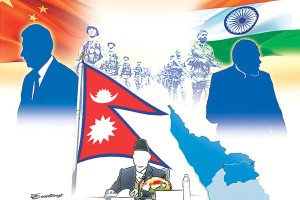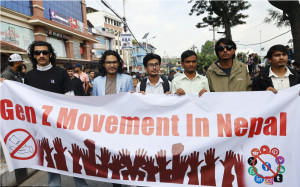Columns
The novel coronavirus puts Nepal’s economy under the microscope
The direct effects of Covid-19 might be bad, but the potential economic shock can be catastrophic.
Paban Raj Pandey
The adverse fallout from the coronavirus is being felt globally. Governments and central banks have aggressively responded with expansionary fiscal and monetary policy. Yet, normal life has been brought to a standstill. No one argues that the world is in recession, or that it is heading quickly to one—the right question is how hard and how deep. Nepal obviously will not remain immune to the pandemic’s negative repercussions. This may, in fact, be time for policymakers to lay out a plan for something worse—just in case.
Before the virus first surfaced in Wuhan, China last December, the global economy had just weathered a US-China trade war. Germany was already on the brink of recession. In the subsequent two months, Chinese manufacturing output dropped 15.7 percent from the same time a year ago. Automakers in both the US and Europe have idled plants, following similar action in China, South Korea and Japan. Visitors to Japan tumbled 58 percent in February—the most since the 2011 earthquake there. Similar stories are easier to come by in every country and every region now.
Major income earners are hurt
Tourism in Nepal is a source of both direct and indirect employment and is a major foreign exchange earner. In 2019, 1.17 million international tourists came into the country. This year, the government had a goal to attract two million. The optimism surrounding the Visit Nepal Year 2020 likely led to a hotel building spree. Now, hotels point out that occupancy has dropped to new lows. As of mid-February this year, banks and financial institutions (BFIs)—27 Class A commercial banks, 24 Class B development banks and 22 Class C finance companies—had extended Rs139 billion to the ‘hotel or restaurant’ sector, up from Rs67 billion at mid-July 2017.
As of mid-February, BFIs had a total loan book of Rs3,186 billion, up from Rs1,977 billion at mid-July 2017. The non-performing loan ratio for commercial banks was 1.71 percent and for development banks, 1.21 percent. This can rise quickly once loans begin to go sour. By mid-February, BFIs had Rs67 billion in loan-loss provision, up from Rs53 billion at mid-July 2017. In contrast, in the last fiscal year that ended mid-July 2019, 28 commercial banks (now 27) doled out Rs47 billion in dividends, Rs26 billion of which was in cash. This was out of Rs64 billion in profit. Not enough was retained.
Good times do not always last. Remittances’ role in the Nepali economy has substantially increased over the years. In the last fiscal year, they totaled Rs879 billion, which equalled a quarter of the country’s gross domestic product. In the first seven months of the current fiscal, they dropped 0.5 percent year-over-year to Rs513 billion; they should continue to come under pressure in the months and quarters to come.
Malaysia, South Korea and the Middle East are top destinations for Nepali workers. Malaysia is one of the leading hubs for the tech supply chain in the Far East. South Korea is a top exporter of semiconductors, autos and electronics. A global downturn is bound to hurt their exports, and by default, the need for workers. In the meantime, crude oil is in the midst of both a supply and a demand shock. After failing to strike a deal to cut output, Saudi Arabia and Russia are both ramping up production, even as the coronavirus saps global demand. Brent crude collapsed from $71.75 per barrel in early January to $25.30 per barrel towards the end of March. Major oil-producing countries will be tightening their belts.
Prepare for the worst—just in case
Remittances are a major source of foreign exchange reserves, which stood at $9.64 billion mid-February—enough to cover 8.5 months of imports. Policymakers have a juggling act ahead on how to deal with rising unemployment, business failures and falling reserves. The government just announced a relief package which mandates, among others, that food to the needy be provided at the local level and employers continue to pay workers during the lockdown. Nepal Rastra Bank cut the cash reserve ratio for BFIs to three percent from four percent. Borrowers facing a mid-April loan-installment deadline can now make their payment by mid-July.
These are all welcome measures; more are likely in the days and weeks to come. The reality is that if the virus subsides in the weeks ahead, the global economy can snap back quickly. There are several trillion dollars of stimulus money now sloshing around. After all, coronaviruses are known to subside during summer months. But then again, this virus strain could continue to wreak havoc throughout summer. Or it could subside now and come back in the fall. There are several scenarios that could really test the prowess of major central banks like the Federal Reserve, European Central Bank and the Bank of Japan.
In the period around 2007-09, the global financial system was on the brink of collapse. Central banks, by aggressively using both conventional and unconventional monetary tools, prevented that from happening. They fired up the printing presses and began buying their own sovereign bonds, with the EUropean Central Bank and Bank of Japan even venturing into corporate bonds—the latter also into equity Exchange-Traded Funds. Investors took on risk and went up the risk curve. Interest rates fell and stocks surged. Animal spirits were unleashed, and the global economy benefitted from the wealth effect. ‘Do not fight the fed’ became a popular maxim.
The downside to all this was that central banks were now interfering with the natural ups and downs of economic cycles. Their balance sheets ballooned. Global debt rose to a new high, which at the end of last September stood at $253 trillion. Global GDP in 2018 was $84 trillion. The mismatch raises the risk of what would otherwise be a plain-vanilla downturn morphing into something more serious. At a time when it increasingly takes more debt to produce the same output, it does not take long for a negative feedback loop to take hold.
Once again, the global economy has sustained a severe blow. Just to focus on the US Federal Reserve, by the middle of March, in two emergency meetings, it cut its policy rate by 125 basis points, to zero-bound. This was then followed by an announcement on March 23 of unlimited quantitative easing, plus the expansion of facilities to purchase certain types of corporate and municipal debt. In essence, the US central bank is all in. But unlike in the past, it is taking longer for financial markets to stabilise. If markets begin to rebel, central banks will have their work cut out. The global economy can unravel quickly. In this scenario, Nepal’s economy will be at risk of a much bigger shock than that directly inflicted by the virus. Of course, if the worst does not come to pass and the can once again gets kicked down the road, the world can move on. But there is no harm in devising a plan for a significant downturn—just in case.
***
What do you think?
Dear reader, we’d like to hear from you. We regularly publish letters to the editor on contemporary issues or direct responses to something the Post has recently published. Please send your letters to [email protected] with "Letter to the Editor" in the subject line. Please include your name, location, and a contact address so one of our editors can reach out to you.




 21.12°C Kathmandu
21.12°C Kathmandu















